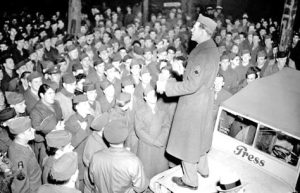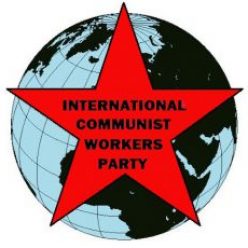Philippine Battles: How Communist Soldiers Can Destroy the Imperialists’ Armed Might here ♦ The Philippine Huk Insurgency and the Failed “United Front” Strategy here ♦

US Army Sgt. George Black addresses US troops in front of the US Embassy in Paris, France, January 1946, amidst massive global protests against counterinsurgency operations in the Philippines
Philippine Battles: How Communist Soldiers Can Destroy the Imperialists’ Armed Might
The US-Philippine war (1899-1902) erased any questions about US imperialist ambitions. President McKinley promised independence, but double-crossed Filipinos who had sided with the US to defeat the Spanish imperialists. His administration was determined to dominate the islands at any cost.
This bloody war, which heralded the age of US imperialism, cost the lives of 250,00O Filipinos, and the decade-long fight against Spain another 600,000. “It amounted to genocide,” said a US marine veteran who organized among US troops during the Vietnam War.
“The conflict between these two world powers, and social upheaval in Europe, set the stage for war over colonies globally. Whenever this happens, the opportunity presents itself for communists who have prepared carefully through their work in the military to organize workers to take control.
“It could easily happen now, paving the way for communist revolution,” he concluded.
Internal Vulnerability of Imperialist Armies
The US army brought more than advanced weapons and 125,000 troops to the Philippines. It also brought virulent racism.
While war raged in the Philippines, racist murder spiked in the US. On April 22, 1899, a white mob tortured and lynched Sam Hose, a Black worker, in Georgia.
The seven thousand Black soldiers who fought in the US-Filipino war knew about Sam Hose. The racist propaganda directed at Filipinos to justify US imperialism was like the racist lies used to justify torture and lynching of Black people in the US.
Black soldier David Fagen had enough. He deserted and joined the Filipino army of liberation, leading guerrilla attacks on US imperialists. He had many sympathizers among Black soldiers stationed in the Philippines. His actions were hotly debated throughout the US, particularly in the socialist and Black presses. Many white soldiers and workers were also disgusted by the US government’s racist war.
Even before the Bolshevik revolution in Russia sparked the massive growth of communist parties worldwide, the racism that accompanied imperialism was the most vulnerable point of capitalist/imperialist armies.
Communists Lead Multi-Racial Fights against US Imperialists’ Plans
After World War II, the US army leadership—blessed by the Roosevelt/Truman administrations—prepared to attack their Filipino allies again. The US aimed to crush the Filipino communist-led Hukbalahap army (Huks) that had fought Japanese imperialism. But this time they couldn’t mobilize the troops to do it.
Over 20,000 U.S. soldiers marched in Manila, demanding to return home. Another 20,000 demonstrated in Honolulu. Three thousand joined them in Korea, and 5,000 in Kolkata. In Guam, 3,500 Air Force troops staged a hunger strike.
The US armed forces were still segregated. All 250 members of the all-Black 823rd Engineer Aviation Battalion wrote to tell President Truman they were “disgusted with American foreign policy” and did not want to “take the field in league with rulers who were against the freedom revolts of oppressed peoples.”
Erwin Marquit, a white communist sailor, recounted proudly in his memoir how “The Communists and those allied with them helped guide the GI outburst into a powerful, well-organized movement.” Its goal was to resist “the overtly imperialist ambitions latent in the new US role in the postwar world.”
Toby Schwartz, another communist, remembered two demonstrations in Manila. During the first, he was elected to a small delegation that presented the soldiers’ demands. It told the general staff that the US troops would not fight against their Filipino allies. The general staff threatened to charge the whole delegation with mutiny.
The soldiers answered with another demonstration. This time they brought their tanks. The general staff dropped the threats and abandoned plans to crush the Huks.
Turn the Guns Around
The ICWP rejects reform campaigns to “bring the troops home.” We aim to build a communist base in all capitalist armies. History has taught us that there can be no communist revolution without winning the soldiers.
Imperialist armies portray themselves as all-powerful. Filipino activists and veterans of the US Army and Marines, members or friends of ICWP, discussed whether this is true. We had all previously accepted the propaganda that weapons and money determine who will win militarily. Afterward, we changed our minds. Internal contradictions in the armed forces – such as racism vs. anti-racism – are what primarily determine who wins wars.
Capitalist/imperialist armies are not invincible monoliths. The communist class fight against racism, sexism, nationalism, and casteism opens the door to our goal of turning the guns around. The ICWP has and will continue to organize in the bosses’ armed forces. This time we will settle for nothing less than global communism.
The Philippine Huk Insurgency and the Failed “United Front” Strategy
The Hukbalahap was organized in the Philippines in 1942 to fight Japanese imperialism. This guerrilla army had strongholds in Luzon, based on earlier peasant movements. They fought, sometimes with and sometimes against, anti-Japanese guerrilla units organized by the US Army and the Philippine colonial armed forces.
This was the international communist movement’s general strategy: the United Front Against Fascism. Communists in Japanese-occupied colonies including Vietnam, Indonesia and Malaysia as well as in China formed united-front resistance armies. They halted the class struggle in the countryside during the fight against Japanese occupation. Communists allied with the supposedly “progressive national bourgeoisie” and “lesser-evil” imperialists. After the war, they said, the guerrilla armies would lead revolutions to fight for power.
The Communist Party of the Philippines (PKP) followed this strategy. After the war, however, PKP leaders continued their united front, participating in national elections, while Huk peasant units continued the class war against the landlords.
Mass resistance among US troops temporarily prevented the US government from smashing the Huks. But the US government coordinated counterinsurgency with the Philippine colonial government and, after 1946, with the US-backed Philippine government.
By 1949, the PKP had abandoned elections and was engaged in armed insurgency. Within a year, fifteen thousand armed Huks were fighting a civil war.
US President Truman ordered all-out military and financial aid to the Philippine Army’s anti-insurgency campaign in 1950. By the end of 1954, the Huks’ armed struggle was effectively over.
Winning a national liberation struggle does not mean a victory for the masses. Communists in Vietnam, for example, put off fighting for communism to fight the Japanese, the French, and finally the US. By then, they were no longer committed to fighting for communism. Vietnam is now a capitalist paradise where masses of workers produce clothes and other commodities for the global market.
Even when national liberation movements “win” a battle, they lose the war for the liberation of the working class.
Read our Pamphlet:
“Soldiers, Sailors, Marines: Crucial for a Communist Workers’ Revolution”
available here

